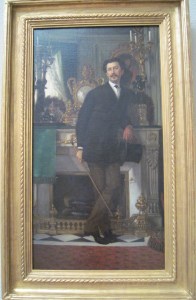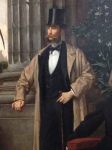To cite this article: Paquette, Lucy. “Masculine Fashion, by James Tissot: Officers, soldiers & sailors (1868 – 1883/85).” The Hammock. https://thehammocknovel.wordpress.com/2016/06/30/masculine-fashion-by-james-tissot-officers-soldiers-sailors-1868-188385/. <Date viewed.>
“Our industrial and artistic creations can perish, our morals and our fashions can fall into obscurity, but a picture by M. Tissot will be enough for archaeologists of the future to reconstitute our epoch.”
~ L’Artiste, 1869, in a review of Tissot’s painting, Young Ladies Looking at Japanese Objects, exhibited at the Paris Salon
It was not just women’s fashions that James Tissot painted with the precision of a photojournalist recording the sights around him; he also recorded military men in detail, giving us a glimpse of life in his time.

Beating the Retreat in the Tuileries Gardens (1867), by James Tissot. Private Collection. (Photo: Wikipaintings.org)
This painting, which Tissot exhibited at the Salon in 1868, features four Imperial Guardsmen: three Hussars and a Zouave.
In 1830, numerous members of the fierce Kabyli tribe of Zouaoua living in the rocky hills of Algeria and Morocco volunteered to fight with the French colonial army. In 1852, Napoléon III, Emperor of the French, ordered the Zouaves – by that time native Frenchmen stationed in Algeria – restructured into three regiments of the regular French Army. The Zouave regiments served in The Crimean War (1853 – 1856). On December 23, 1854, the Emperor created a fourth regiment, the Zouaves of the Imperial Guard; detachments from the Zouave regiments serving in the Crimea were brought together on March 15, 1855 to form it. They were based at Saint-Cloud until 1857, and subsequently at Versailles. The Zouaves of the Imperial Guard served through all the campaigns of the Second Empire, including the Franco-Austrian War of 1859 and the Mexican Intervention (1864-66).
The Zouaves earned a reputation for reckless bravery, and they became famous for their distinctive uniforms, which included a short, collarless, open-fronted jacket, baggy trousers, sashes and Oriental head gear, modelled on Algerian native dress. The Zouave drummer in Tissot’s painting wears a blue uniform with gold trim, leggings, a white turban with a golden tassel, and white spats over his black leather shoes.
The Hussars, in their smartly-tailored blue, red and gold uniforms, are possibly from the 9th Hussar Regiment, formed in 1852 as the régiment des guides. In 1854, it became the régiment des guides de la Garde Impériale.

Frederick Burnaby (1870), by James Tissot. National Portrait Gallery, London. (Photo: Wikimedia.org)
Tissot painted this portrait of Frederick Gustavus (“Gus”) Burnaby (1842-1885) sometime between the autumn of 1869 and the summer of 1870. Burnaby, a captain in the Royal Horse Guards (3rd Household Cavalry, “the Blues”), was 27 or 28 years old and mingled with the Prince of Wales’ social set.
He is shown off duty, smoking and conversing in his “undress” uniform of a dark blue coat with a standing collar, scarlet and gold trimmings, a white cross-belt, and long blue trousers with red stripes sewn along the outer seams. He wears highly polished black leather shoes, and his military cap is beside him. Behind him, his full-dress uniform is laid out: a plumed silver-gilt helmet, frogged cape, polished metal cuirass (breastplate), and thigh-high black riding boots.

The Empress Eugénie and the Prince Impérial in the Grounds at Camden Place, Chislehurst (c. 1874), by James Tissot. Musée Nationale du Château de Compiègne, France. (Photo: Wikimedia.org)
The Empress Eugénie and the Prince Impérial in the Grounds at Camden Place, Chislehurst (c. 1874) depicts the exiled French Empress, living outside London after the collapse of the Second Empire, and her son, Louis-Napoléon Bonaparte (1856-1879), the Prince Impérial. The only child of Napoléon III of France, he was accepted to the Royal Military Academy, Woolwich, in 1872 and is pictured in the uniform of a Woolwich cadet. He wears a jacket with a standing collar, trimmed in red and gold with a single row of brass buttons, long trousers, and a round cap with a gold band.
Upon his father’s death in January, 1873, Bonapartists proclaimed him Napoléon IV. When the Prince turned 18 in 1874, thousands of French citizens traveled to fête him in Chislehurst: the railway station flew the tricolour of France, while in the main waiting room an inscription, wreathed in laurels and violets, read, “Vive le Prince Impérial 16 mars, 1874.” He made a speech to rapturous crowds.
The Prince Impérial proved himself an excellent student at Woolwich – seventh in a class of thirty-four – and graduated in early 1875.
In The Gentleman Cadet: His Career and Adventures at the Royal Military Academy, Woolwich: a Tale of the Past (1875), Alfred Wilks Drayson (I827-1901) recalled, “It was ten days after joining the Academy that I first obtained my uniform, and I can recall even now the secret pride with which I first put it on. I felt now that I really had commenced the career of a soldier…There seemed to come upon me a feeling of responsibility as the coat came on me, and I made up my mind not to disgrace my cloth.”
Louis-Napoléon became friends with members of the British Royal Family, especially with the Prince of Wales. He was advised not to join the regular service of the British Government, and therefore was not commissioned as an officer. He was killed in 1879, at age 23, in the Zulu War.

Reading the News (c. 1874), by James Tissot. Private Collection. (Photo: Wikimedia.org)
Reading the News (c. 1874) is an enigmatic painting featuring a lovely woman wearing a yachting costume, at a tea table with a Chelsea pensioner in his navy blue “undress,” or casual uniform. What is a Chelsea pensioner? He (or, since 2009 – she) is one of about 300 residents at the Royal Hospital Chelsea, a retirement home and nursing home for former members of the British Army located on Royal Hospital Road in west London. They surrender their army pension and live within the Royal Hospital, free of financial worries while enjoying comradeship, full medical care and catering services, and a wide range of activities including charitable causes. Chelsea pensioners may come and go from the Royal Hospital as they please, and they are permitted to wear civilian clothing when they travel. But within the Hospital, and in the surrounding area, they wear the blue uniform (the RH on the man’s hat is for Royal Hospital). For ceremonial occasions, they wear distinctive scarlet coats and black tricorne hats.
.jpg)
The Gallery of HMS Calcutta (Portsmouth), c. 1876, by James Tissot. Tate, London. (Photo: Wikimedia.org)
Though the male in this painting is a minor character who could have been any man from a dandy in a lounge suit to an older figure in a frock coat, Tissot lends added interest to The Gallery of HMS Calcutta (Portsmouth) by depicting him as a low-ranking naval officer. Looking rather off-duty here, the young ensign slouches over the rail with his cap pushed back – considering the company on this hot summer day, perhaps his brow is sweaty?

Sans dot (Without a Dowry, 1883-85), by James Tissot. [One of a series of fifteen large-scale pictures called La Femme à Paris (The Parisian Woman).] Private Collection. (Photo: Wikimedia.org)
Over a dozen years after the fall of the Second Empire, these officers wear finely-tailored uniforms reminiscent of Captain Burnaby’s from 1870. The officer on the left wears a double-breasted blue coat with a red- and gold-trimmed standing collar, button-down shoulder straps, triple rows of brass buttons, and red cuffs with gold embroidery. Under this, he wears a high-collared white shirt. His long blue trousers have a red stripe down the outer seams, and his blue képi (cap) has a dark blue band and a black leather visor. He wears pristine white gloves.
The officer on the right wears a blue coat with a high red collar and red cuffs with gold embroidery. In the back, its double vent is embellished with brass buttons. His high-collared white shirt peeks out as well. His long red trousers have a blue stripe sewn down the outer seams. His red képi has a blue band, and he also wears white gloves – along with pince–nez. The gold braid trim on the shoulders of his coat indicates his higher rank.
In these paintings, Tissot painted a brief survey of military men of his era, from a young cadet to a retired member of the British army, from snappy officers to slouching ensigns, and from the exotic to the everyday.
Related post:
Masculine Fashion, by James Tissot: Aristocrats (1865 – 1868)
© 2016 by Lucy Paquette. All rights reserved.
The articles published on this blog are copyrighted by Lucy Paquette. An article or any portion of it may not be reproduced in any medium or transmitted in any form, electronic or mechanical, without the author’s permission. You are welcome to cite or quote from an article provided you give full acknowledgement to the author.
 If you do not have a Kindle e-reader, you may download free Kindle reading apps for PCs, Smartphones, tablets, and the Kindle Cloud Reader to read The Hammock: A novel based on the true story of French painter James Tissot. Read reviews.
If you do not have a Kindle e-reader, you may download free Kindle reading apps for PCs, Smartphones, tablets, and the Kindle Cloud Reader to read The Hammock: A novel based on the true story of French painter James Tissot. Read reviews.
The Hammock: A novel based on the true story of French painter James Tissot, brings Tissot’s world from 1870 to 1879 alive in a story of war, art, Society glamour, love, scandal, and tragedy.
Illustrated with 17 stunning, high-resolution fine art images in full color
Courtesy of The Bridgeman Art Library
(295 pages; ISBN (ePub): 978-0-615-68267-9). See http://www.amazon.com/dp/B009P5RYVE.

















